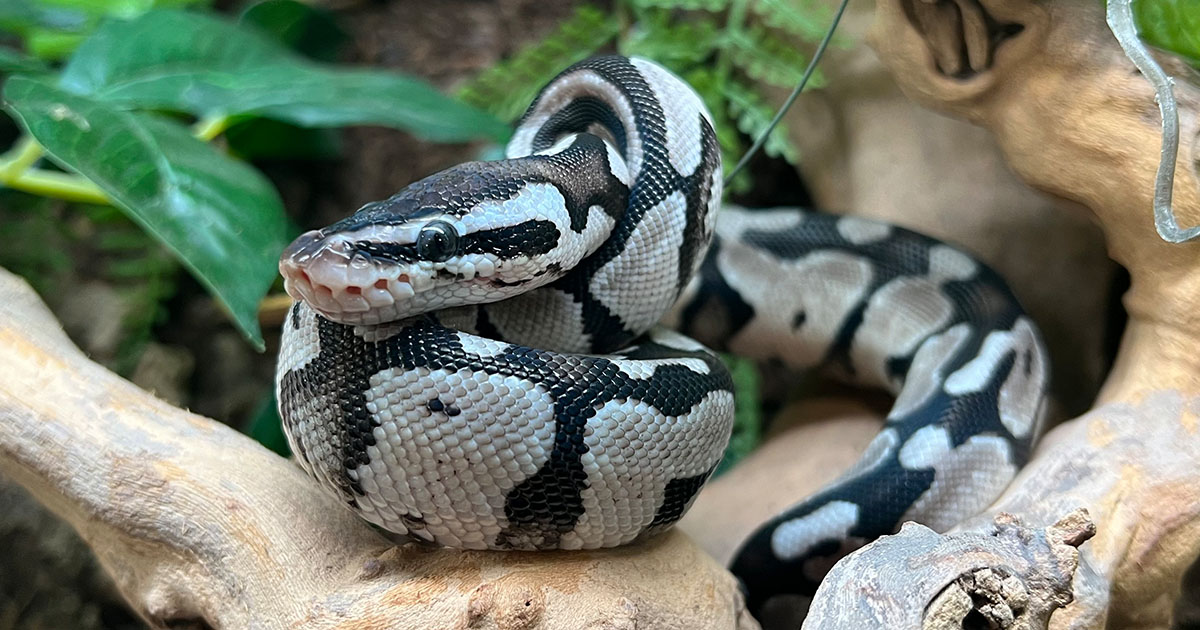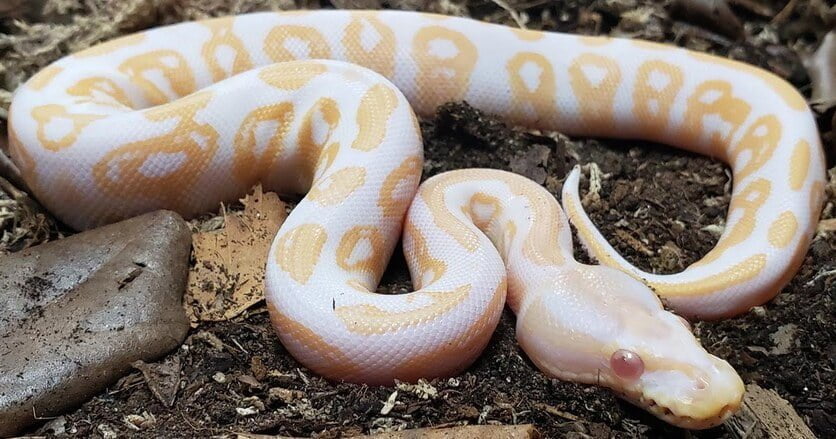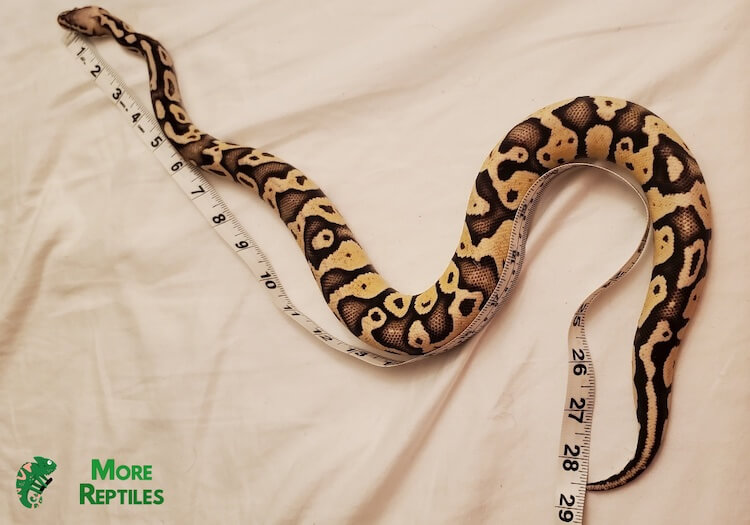Ball pythons, or “royal pythons,” are docile and calm snakes native to the grasslands of West and Central Africa. When threatened, these friendly companions curl into a tight “ball” with their heads protected in the center, hence the name. With their manageable size, usually reaching 3 to 5 feet in length, and minimal ball python care needs, this species makes the best reptile for both novice and experienced keepers.
These wiggly pets come in many colors, from albino and purple to dark brown, with black belly markings and light brown blotches on the undersides. While resarching ball pythons for sale, it’s essential to be familiar with their specific needs to ensure they remain happy and healthy in captivity. So, read our detailed ball python care sheet before bringing your new reptile pet home!
Ball Python: Overview & Characteristics
Ball Pythons are non-venomous constrictors with stout and muscular bodies designed for catching prey in the wild. Compared to other python species, they are relatively small and manageable, with hatchlings measuring 10 to 17 inches in length. The natural coloration of a wild-type ball python consists of brown and black patterns.
It also has lighter brown or tan markings, creating a unique “alien head” pattern along its sides. The belly is usually cream or white with scattered black markings. Thanks to their manageable size, ball pythons do not require massive enclosures, making them suitable for indoor keeping. These docile reptiles can live for 15-30 years in captivity if you give them good ball python care, providing long-term companionship.
Here are a few reasons why ball pythons are a preferred reptile for many pet owners:
- Docile Nature: These snakes have a calm temperament and rarely exhibit aggressive behavior. Pythons are easy to tame with regular, gentle handling.
- Manageable Size: Adult ball pythons usually grow to a length of 3 to 5 feet, which is manageable for most owners. They are also easy to house without large enclosures.
- Ease of Care: Compared to many other pets, ball pythons are relatively low maintenance. They don’t require daily feeding, extensive grooming, or large space.
- Longevity: With proper ball python care, these snakes can make a friendly companion for 15-30 years. This long lifespan means you get years of bonding with your reptile pet.
Ball Python Morphs
A ball python morph is a genetic variation of the species that has been selectively bred for different colors and body patterns. Hundreds of different morphs are on the market today, and more combinations are being produced each year. Here are a few popular ball python morphs loved by both reptile enthusiasts and collectors.
1. Albino
The Albino morph results from a genetic mutation where the body does not produce enough melanin. Consequently, these snakes are bright yellow or white in color and have white scales over their body. Albinos also have prominent red or pink eyes with orange or peach rings on the sides. This makes them one of the most-wanted ball python species.
2. Pied
The Piedbald or Pied morph is caused by a “recessive” trait where the snake has non-pigmented white patches on its scales. These pythons have the same dark brown or black skin with light brown patches on their sides. But they also have large white (uncolored) patches of different sizes across their body, creating a contrasting color pattern.
3. Banana
Named for its resemblance to the color of a ripe banana, the banana morph features a lively and cheerful palette. These snakes have a bold yellow base color with some scattered purple or orange spots on the undersides. Besides its small speckles, light purple bands or stripes overlay the python’s body, like the classic morph.
4. Blue Eyed Lucy
The blue eyed leucistic morph or blue eyed lucy ball python as it is commonly known is a fan favorite for both it’s paper white coloration and the clear blue colored eyes.
As the name says, the “Blue eyed Lucy” morph is like no other ball python morph is that is has no color pigment or pattern what so ever. This is a huge shift from the wild type ball python which is a combination of black, gold and brown colors with a heavy pattern throughout.
Ball Python Size
Ball pythons are usually sold as hatchlings, which are around 10 to 17 inches in length. At the time of sale, these baby pythons typically weigh between 80 to 100 grams. However, this may vary depending on the size of the eggs they hatched from and their initial growth rate. Generally, a 10-gallon ball python setup is ideal to keep a baby python happy and healthy.
Like most snakes, adult female pythons usually grow larger than the male species, at 3 to 5 feet long. Males, on the other hand, average 3 to 4 feet in length, making them suitable for those with limited space. If you want to house an adult snake, migrate to a 40-gallon enclosure, which gives the animal ample space to stretch out fully.
Life Span: Captivity vs Wild
With proper ball python care, these snakes can make a long-lived companion, accompanying you for 15-30 years in captivity. In fact, Saint Louis Zoo, Missouri, hosts a 62-year-old ball python known to be the oldest of these living species. If you want your wiggly pet to live longer, provide a well-balanced diet, a warm enclosure, and regurlar handling.
In the wild, ball pythons tend to have shorter lifespans than in captivity, averaging around ten years. This may be due to poor living conditions, the unavailability of prey, and predation. Habitat destruction by deforestation, parasitic outbreaks, and extreme temperatures also contribute to this shorter lifespan.
Ball Python Habitat
Ball pythons (Python regius) inhabit the warm, tropical lands of West and Central Africa. You’ll find these pythons in the following ecological niches within these regions:
- Savannahs: These are grassland ecosystems with scattered trees and shrubs. Savannahs provide an open canopy and ample sunlight, which fulfills the ball python’s needs for thermoregulation and hiding spots.
- Grasslands: These regions are similar to savannahs but have fewer trees, as the lands are covered mainly by grass. Grasslands offer open areas for these them to hunt and find shelter.
- Open Forests: Providing the perfect balance of open space and forest cover, open forests are perhaps the most usual habitat for ball pythons. They have widely spaced trees, grasses, and shrubs, with lots of mammals and birds serving as prey.
Lighting and Temperature
Proper lighting and temperature are crucial for ball python care, as they help maintain the health and well-being of these snakes. Since these snakes come from the warm regions of Africa, it is imperative to replicate the same environment in captivity. This helps ensure that these animals reach their full growth potential, becoming a long-lived companion.
Ball Python Temperature
Like all reptiles, ball pythons are ectothermic or cold-blooded animals, which means that they don’t generate their own body heat. They rely on external heat sources to regulate their body temperature. Thus, you should maintain a proper gradient of temperatures within their enclosure to help them thermoregulate effectively.
Generally, the basking temperature, or the warm end of the enclosure, should be maintained at 95°F. This temperature helps them warm up and also aids in digestion and other metabolic functions. Similarly, the cool end of the enclosure should be kept at around 78°F, giving the reptile a place to retreat if it gets too warm.
Here are a few tips to maintain the right temperature for ball python care:
- Thermometers: Place two thermometers to regularly monitor the tank’s temperature, with one in the basking zone and the other in the cool zone.
- Basking Lamp: Install a basking lamp over the tank along with a 50 watt heat lamp bulb (maximum) to provide radiant heat to the reptile. Note: this is not alwasy needed and the under-tank heater is recommended.
- Heat Mat: If the heat lamp fails to hit the right temperatures, place a heat mat or under-tank heater on one side of the enclosure. This helps create a warm basking spot.
Ball Python Lighting
Ball pythons are nocturnal creatures that do not have intense lighting requirements. However, providing a proper day/night cycle is always beneficial as it supports the reptile’s overall health and growth. On average, you should provide your python 8-10 hours of UVA/UVB light exposure daily to mimic natural sunlight.
While UVB lighting isn’t necessary for the survival of your pet snake, providing a light source may help regulate their circadian rhythm. It may also improve the python’s immune system, thus improving its overall well-being. The best light source for ball python care is a low-strength UVB fluorescent bulb, which provides ambient lighting in an energy-efficient manner.
Note: Since UVB bulbs decrease in potency over time, it is essential to replace your lighting source every six months, even if they still emit light. When choosing a UVB light for ball python care, go for one with a 0.7 to 1.0 zone range. The maximum UVI in the basking zone should be 1.1 to 3.0. We recommend a 5.0 UVB bulb.
Ball Python Diet
Ball pythons usually feed on rodents, with mice and rats making up the major portion of their meals. When your pet reptile is young, feed them with rat pups or crawlers and increase the diet size as they grow. A good rule of thumb is to choose prey items that match your python’s girth in size. In other words, the prey should be the same width as the widest part of the snake’s body.
Moreover, it’s better to feed your reptile in a separate enclosure. This will help the pet learn not to associate your hand or the opening of its enclosure with feeding. Also, use feeding thongs to feed the pet instead of using your fingers. Since ball pythons are nocturnal creatures, the feeding sessions should preferably be held at night.
Here is the feeding frequency for proper ball python care, depending on their growth stage:
- Baby pythons: Once a week
- Juvenile ball pythons: Once a week
- Adult pythons: Once every 1-2 weeks
Supplements
Many reptile parents think that their ball pythons would get all of the necessary nutrients from their rodent-rich meals. Naturally, they don’t feel the need to treat their wiggly friends with supplements. But here’s the thing: the nutrient quality of feeder rodents is usually lower than the ones consumed by their counterparts in the wild.
Since these rodents are commercially bred for feeding, they often have a lower nutrient content than wild rodents. This may lead to a nutrient deficiency in your python, especially if it is not getting the required vitamin D intake. To counter this, it’s best to occasionally supplement your pets meals with a vitamin D powder supplement. Simply sprinkle the powder on the meal item prior to feeding.
Thawing Frozen Food for Ball Pythons
It is recommended to feed frozen-thawed rodents to your snake rather than live ones. This is because live rodents may injure your pet in defense, which sometimes leads to wounds and life-threatening infections. Here’s how to thaw frozen food for ball pythons:
- Take out the required number of frozen food items from the freezer.
- Place each frozen prey into a separate, sealed plastic bag.
- Place the sealed bags of prey into the cold water and let them sit until they’re no longer frozen.
- Once the prey items are thawed, discard the cold water from the container.
- Fill warm water in the container and let the thawed prey sit for around 15 minutes.
- Discard the water, and run warm water over the food items to bring them to normal temperature.
- Take the thawed meal out of the plastic bag and feed it to your reptile using feeding tongs.
- If the snake does not take the meal right away try using a hair dryer or a heat lamp to warm up the prey item above room temperature.
Note: Never use a microwave to warm frozen prey as it may heat unevenly, potentially causing hot spots. Likewise, do not refreeze thawed prey, as it may encourage bacterial growth.
Hydration
Access to fresh, clean water is crucial for ball python care, as it supports many of its normal bodily functions. This includes digestion, thermoregulation, and shedding. To meet the hydration needs of your reptile, choose a water dish that is large enough for the python to soak. A dish with a diameter that allows the animal to curl up inside is good to go.
Pick a heavy, stable dish made from materials like ceramic or sturdy plastic so it doesn’t tip due to your python’s weight. The depth should be around 1-2 inches to give your pet ample space to access the water. In addition, soak your reptile for 15-20 minutes in warm water once or twice a week. This helps with hydration and loosens the old skin, thereby making shedding easier.
Besides food and water, ball pythons also need the right humidity levels to thrive in captivity. Ideally, you should maintain a humidity range of 40-60{a47be734f0df8d7f120a7df290cf380c79376e8356d1aab405383bb23aa6ce67} inside your pet’s enclosure — and increase it to 70{a47be734f0df8d7f120a7df290cf380c79376e8356d1aab405383bb23aa6ce67} during the shedding period. To attain these levels, fill a hide area with sphagnum moss which you mist once or twice a day using a spray bottle, depending on ambient humidity.
Ball Python Care & Health
Shedding
Healthy ball pythons shed their skin periodically as they grow through a process called ecdysis. Usually, juvenile snakes shed every 4-6 weeks, while adults only shed a few times annually. A proper shed will come off in one complete piece, including the eyepiece, but it’s not uncommon for the skin to break off.
Here are a few signs that your pet is about to shed:
- Decreased appetite
- Cloudy blue or grey eyes
- Lethargy and dull old skin
- Whitish sheen on the skin
- Increased hiding frequency
Mites & Worms
Ball Python Mites
Snake mites are small external parasites that feed on the python’s blood (acariasis), leading to irritation and anemia. Symptoms include tiny black dots around the eyes and scales, prolonged soaking, and restlessness. If your snake shows any of these signs, schedule a thorough cleaning and disinfection of its enclosure. Plus, treat the reptile and its enclosure with ivermectin and set up a ball python care appointment with your veterinarian.
Ball Python Worms
Worms are internal parasites like nematodes and cestodes that can infect ball pythons, usually transmitted through infected prey. If your python is infected by internal parasites, it may display symptoms like regurgitation, weight loss, and lethargy. In this case, set up a fecal examination by a veterinarian, and start using prescribed anthelmintic medications.
Handling and Temperament
Ball pythons are known for their calm and non-aggressive nature. They are generally easy to handle and rarely bite, making them suitable for first-time snake parents. Pythons have a natural tendency to not resort to aggressive behavior when they feel threatened. Instead of attacking or fighting, they curl up into a tight ball (in defense) to protect themselves.
Here are a few tips for ball python handling:
- When petting a ball python, use gentle or slow movements and avoid jerky motions
- Avoid petting near the head until the snake is comfortable with being handled
- Use both hands to support the snake’s entire body when holding it
- Maintain a loose grip to allow the snake to move freely and avoid squeezing
- Approach the python slowly when picking it up, and let it see your hand first
- If the snake is tightly coiled or showing signs of stress, give it some time to relax
- Avoid handling right after feeding or during shedding, as the snake might be stressed
Ball Python Care Sheet Conclusion
Ball pythons are docile and long-lived pets that provide years of bonding if proper ball python care is provided. Thanks to their low-maintenance requirements, these reptiles grow healthily even with weekly feeding and grooming sessions. So, whether you’re a beginner or an experienced keeper, ball pythons are a great addition to your collection.




